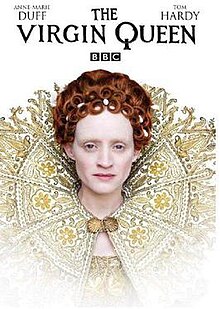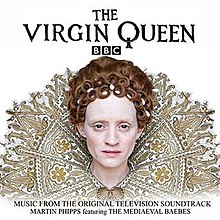
Elizabeth I was Queen of England and Ireland from 17 November 1558 until her death in 1603. She was the last monarch of the House of Tudor.

Robert Devereux, 2nd Earl of Essex, KG, PC was an English nobleman and a favourite of Queen Elizabeth I. Politically ambitious, and a committed general, he was placed under house arrest following a poor campaign in Ireland during the Nine Years' War in 1599. In 1601, he led an abortive coup d'état against the government of Elizabeth I and was executed for treason.
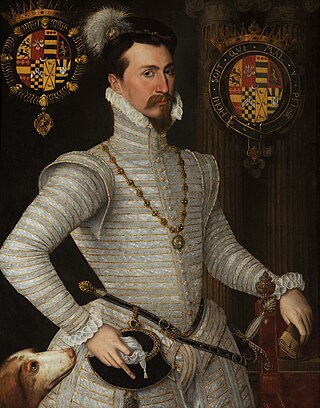
Robert Dudley, 1st Earl of Leicester, was an English statesman and the favourite of Elizabeth I from her accession until his death. He was a suitor for the queen's hand for many years.
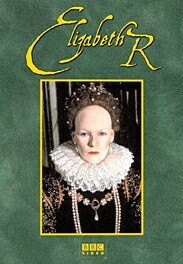
Elizabeth R is a BBC television drama serial of six 90-minute plays starring Glenda Jackson as Queen Elizabeth I of England. It was first broadcast on BBC2 from February to March 1971, through the ABC in Australia and broadcast in the United States on PBS's Masterpiece Theatre. The series has been repeated several times, most recently from 15 March 2023, by BBC Four.

Elizabeth is a 1998 British biographical period drama film directed by Shekhar Kapur and written by Michael Hirst. It stars Cate Blanchett in the title role of Elizabeth I of England, with Geoffrey Rush, Christopher Eccleston, Joseph Fiennes, John Gielgud, and Richard Attenborough in supporting roles. The film is based on the early years of Elizabeth's reign, where she is elevated to the throne after the death of her half-sister Mary I, who had imprisoned her. As she establishes herself on the throne, she faces plots and threats to take her down.

Walter Devereux, 1st Earl of Essex, KG, was an English nobleman and general. From 1573 until his death he fought in Ireland in connection with the Plantations of Ireland, most notably the Rathlin Island massacre. He was the father of Robert, 2nd Earl of Essex, who was Elizabeth I's favourite during her later years.
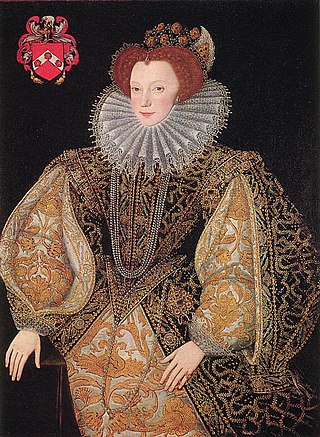
Lettice Knollys, Countess of Essex and Countess of Leicester, was an English noblewoman and mother to the courtiers Robert Devereux, 2nd Earl of Essex, and Lady Penelope Rich. By her second marriage to Elizabeth I's favourite, Robert Dudley, Earl of Leicester, she incurred the Queen's unrelenting displeasure.

Amy, Lady Dudley was the first wife of Robert Dudley, Earl of Leicester, favourite of Elizabeth I of England. She is primarily known for her death by falling down a flight of stairs, the circumstances of which have often been regarded as suspicious. Amy Robsart was the only child of a substantial Norfolk gentleman. In the vernacular of the day, her name was spelled as Amye Duddley.
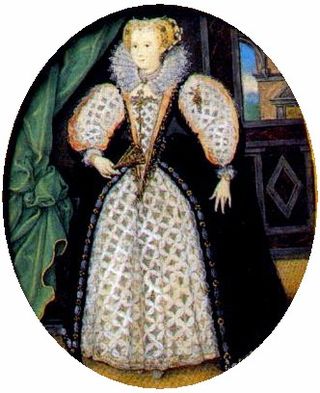
Penelope Rich, Lady Rich, later styled Penelope Blount was an English court office holder. She served as lady-in-waiting to the English queen Anne of Denmark. She was the sister of Robert Devereux, 2nd Earl of Essex, and is traditionally thought to be the inspiration for "Stella" of Sir Philip Sidney's Astrophel and Stella sonnet sequence. She was married to Robert Rich, 3rd Baron Rich and had a public liaison with Charles Blount, Baron Mountjoy, whom she married in an unlicensed ceremony following her divorce from Rich. She died in 1607.

Catherine Carey, after her marriage Catherine Knollys and later known as both Lady Knollys and Dame Catherine Knollys,, was chief Lady of the Bedchamber to Queen Elizabeth I, who was her first cousin.
Knollys, Knolles or Knowles, the name of an English family descended from Sir Thomas Knollys, Lord Mayor of London, possibly a kinsman of the celebrated general Sir Robert Knolles. The next distinguished member of the family was Sir Francis Knollys or Knowles, English statesman, son of Sir Robert Knollys, or Knolles, a courtier in the service and favour of Henry VII and Henry VIII. Robert had also a younger son, Sir Henry, who took part in public life during the reign of Elizabeth I and who died in 1583. From the time of Sir Francis, the family were associated with Greys Court at Rotherfield Greys and Caversham Park, then in Oxfordshire, as well as the nearby town of Reading in Berkshire, where the family's private chapel could once be seen in the church of St Laurence. Lettice Knollys was pronounced the most prominent member of the family, from her birth in 1543 until her death in 1634

Dorothy Percy, Countess of Northumberland was the younger daughter of Walter Devereux, 1st Earl of Essex by Lettice Knollys, and the wife of Henry Percy, 9th Earl of Northumberland.
Sir Christopher Blount was an English soldier, secret agent, and rebel. He served as a leading household officer of Robert Dudley, 1st Earl of Leicester. A Catholic, Blount corresponded with Mary, Queen of Scots's Paris agent, Thomas Morgan, probably as a double agent. After the Earl of Leicester's death he married the Dowager Countess, Lettice Knollys, mother of Robert Devereux, 2nd Earl of Essex. Blount became a comrade-in-arms and confidant of the Earl of Essex and was a leading participant in the latter's rebellion in February 1601. About five weeks later he was beheaded on Tower Hill for high treason.

Sir Francis Knollys, KG of Rotherfield Greys, Oxfordshire was an English courtier in the service of Henry VIII, Edward VI and Elizabeth I, and was a Member of Parliament for a number of constituencies.
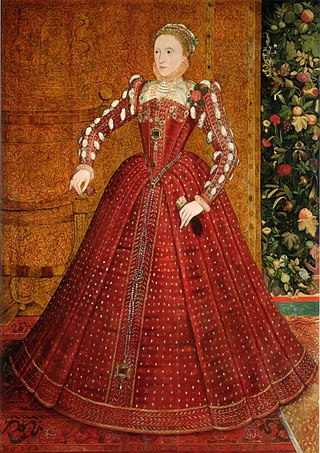
Elizabeth I of England has inspired artistic and cultural works for over four centuries. The following lists cover various media, enduring works of high art, and recent representations in popular culture, film and fiction. The entries represent portrayals that a reader has a reasonable chance of encountering rather than a complete catalogue.

Frances Seymour, Duchess of Somerset was an English noblewoman who lived during the reigns of Elizabeth I, James I, Charles I and Charles II. Her father was Robert Devereux, 2nd Earl of Essex, Elizabeth I's favourite who was executed for treason in 1601. She was the second wife of William Seymour, 2nd Duke of Somerset, and the mother of his seven children.
Lettice FitzGerald, 1st Baroness Offaly was an Irish noblewoman and a member of the FitzGerald dynasty. Although she became heiress-general to the Earls of Kildare on the death of her father, the title instead went to the next FitzGerald male heir when her grandfather, the 11th Earl of Kildare, died in 1585. In 1620, she was created suo jure Baroness Offaly by King James I of England.

Elizabeth Knollys, Lady Leighton, was an English courtier who served Queen Elizabeth I of England, first as a Maid of Honour and secondly, after 1566, as a Gentlewoman of the Privy Chamber. Knollys was the grand-niece of Queen consort Anne Boleyn, which made her a cousin once removed of the Queen. Elizabeth married Sir Thomas Leighton of Feckenham in Worcestershire in 1578. He served as Governor of Jersey and Guernsey.
The Virgin Queen is a 1923 British silent historical film directed by J. Stuart Blackton and starring Diana Manners, Carlyle Blackwell and Walter Tennyson.
Arthur Dudley was a 16th-century man famous for the controversial claim that he was the son of Queen Elizabeth I and Robert Dudley, a man known to have had a long love affair with the queen.
